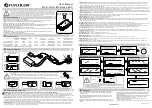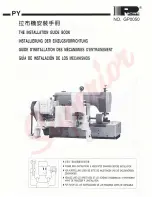
B E C
●
ARM 32-bit Cortex MCU, frequency up to 48 MHZ.
●
International famous brand MOSFET with high performance and low ESR, not afraid of large current;
●
BLHeli_32 firmware,which is designed for superior functionality and performance.
●
Wide voltage support, up to 12S liPo, suitable for x-class drone.
●
Supports regular 1-2ms pulse width input, as well as Oneshot125 (125-250us), Oneshot42 (41.7-83.3us) and
Multshot (5- 25us). The input signal is automatically detected by the ESC upon power up.
Dshot signal is supported at any rate
.
●
Small size, light weight, suitable for the drone with narrow arms.
●
Damped light does regenerative braking, causing very fast motor retardation, and inherently also does active
freewheeling.
●
The silicone twisted-pair of the throttle signal cable
effectively reduces the crosstalk caused by signal
transmission, and makes flight more stable.
●
Aluminum heat sink effectively slow down the temperature rise.
Thank you for using our product. Any Improper operation may cause personal injury or damage to the
product and related equipments. This high power system for RC model can be dangerous ,we strongly
recommend reading the user manual carefully and completely. We will not assume any responsibility for any
losses caused by unauthorized modifications to our product. We have the right to change the design,
appearance, performance and usage requirements of the product unannounced.
Burst Current
(
good heat
dissipation
)
Size
(
For reference)
Weight
(
For reference)
LiPo
Typical
Applications
(For
reference)
User
Manual
Multi
-
Rotor
Brushless
ESC
*
All pictures are for reference only
*Please ensure all solder joints are insulated with heat shrink where necessary.
Programming parameters below can be accessed from the configuration software (BLHeliSuite32):
01
Main features
1
.
Power up:
Once
4
.
If throttle is above midstick for 3 seconds:
This beep sequence indicates that max
throttle has been stored
Once
3.When throttle is above midstick
(measuring max throttle):
While
measuring
5
.
When throttle is below midstick
(measuring min throttle):
While
measuring
6
.
If throttle is below midstick for 3 seconds:
This beep sequence indicates that min
throttle has been stored.
Once
Complete
7
.
Throttle calibration is complete.
After this, the motor will run.
Once
●
Power
off
before
unplugging
,
plugging
in
or
making
any
connections
.
●
It is suggested that keep the ground wire in the original signal wire
connecting well.
●
When some abnormality occurs in ESC driving the motor or need the
motor to reach a higher RPM, user can try to change the timing.
●
Please do not exceed the current range.
●
Please use a PDB or Flight Control with currentmeter if OSD is
required to display the current.
●
Please contact Flycolor sales or technical support for more information.
Con
.
Current
(
good heat
dissipation
)
ATTENTION
Model
OK
4
.
After this, the
motor will run.
LED
*
E S C B L Heli
-
32
firmware:
Flycolor_X_Cross_H V
;
02
Specifications
03
Connect diagram
04
Programming parameter
1
. Rampup power:
Rampup power can be set to relative values from 3% to 150%. This is the maximum power that is allowed when ramping up at low rpms and
during startup. For low rpms, the maximum power to the motor is limited, in order to facilitate detection of low BEMF voltages. Rampup power also affects
bidirectional operation, as the parameter is used to limit the power applied during direction reversal. During startup, the actual applied power depends on throttle
input, and can be lower than the maximum level set by the rampup power parameter, but the minimum level is a quarter of the maximum level.
2. Motor timing:
Motor timing can be set between approximately 1° and approximately 31° in approximately 1° increments (actual accurate values here are
15/16ths of a degree).Typically a medium setting will work fine, but if the motor stutters it can be beneficial to increase timing. Some motors with high inductance
can have a very long commutation demagnetization time. This can result in motor stop or stutter upon quick throttle increase, particularly when running at a low
rpm. Setting timing to high will allow more time for demagnetization, and often helps.
3. PWM frequency:
Motor pwm frequency can be programmed between 16kHz and 48kHz. Higher pwm frequency can run motors smoother. Programmable
frequency also allows for moving of small but potentially disturbing humps in the throttle response. All ESCs have these bumps, with BLHeli_32 they can be
moved in the rpm range, to a place where the system has low sensitivity to them.
4. Demag compensation:
Demag compensation is a feature to protect from motor stalls caused by long winding demagnetization time after commutation. The
typical symptom is motor stop or stutter upon quick throttle increase, particularly when running at a low rpm. As mentioned above, setting high commutation
timing normally helps, but at the cost of efficiency. Generally, a higher value of the compensation parameter gives better protection. If demag compensation is
set too high, maximum power can be somewhat reduced.
5. Maximum Acceleration:
Maximum acceleration can be set between 0.1%/ms and 25.5%/ms. It can also be set to maximum, in which case acceleration is not
limited. Limiting acceleration is primarily intended as a backup parameter that can be used in cases where too hard acceleration gives desyncs. When setting to
e.g. 10%/ms, it means that the power applied to the motor is not allowed to increase by more than 10% per millisecond.
6. Motor Direction:
Rotation direction can be set to Normal/Reversed/Bidirectional 3D/Bidirectional 3D Rev./Bidirectional Soft/Bidirectional Soft Rev. In bidirec-
tional mode, center throttle is zero and above is fwd rotation and below is reverse rotation. When bidirectional operation is selected, throttle calibration is disabled.
7. Startup Beep Volume:
Sets the strength of beeps under normal operation.
8. Beacon/Signal Volume:
Sets the strength of beeps when beeping beacon beeps. The ESC will start beeping beacon beeps if the throttle signal has been
zero for a giventime. Note that setting a high beacon strength can cause hot motors or ESCs!
9. Beacon delay:
Beacon delay sets the delay before beacon beeping starts.
10.Throttle Cal Enable:
If disabled, throttle calibration is disabled.
11. Min throttle, max throttle and center throttle:
These settings set the throttle range of the ESC. Center throttle is only used for bidirectional operation.
The values given for these settings are for a normal 900us to 2100us input signal, and for the other input signals, the values must be scaled. For Dshot input
signal, these settings have no effect.
12.Thermal protection:
Thermal protection can be enabled or disabled. And the temperature threshold can be programmed .
13.Low RPM power protect:
Power limiting for low RPMs can be enabled or disabled. Disabling it can be necessary in order to achieve full power on some low
kV motors running on a low supply voltage. However, disabling it increases the risk of sync loss, with the possibility of toasting motor or ESC.
14.Low Voltage Protection:
Low voltage protection can be set between 2.5V and 4.0V per lipo cell. Or it can be disabled. When enabled, it will limit power
applied to the motor if the battery voltage drops below the programmed threshold. This feature is primarily intended for fixed wing crafts.
15.Current Protection:
This feature is not available
for X-Cross HV 2 series.
16.Current Sense Calibration:
When the current display is not accurate, this value can be adjusted, and the value range is: - 99%
~
154%.
17.Brake on stop:
Brake on stop can be set between 1% and 100%, or disabled. When not disabled, brake will be applied when throttle is zero. For nonzero
throttle, this setting has no effect.
18.LED Control:
LEDs can be controlled on ESCs that support it.
19
.
Non Damped Mode
:
O
FF
-
D
amped
light
is
available
;
O
N
-
No Damped
light
。
20
.
Music Note Config
:
Set up personalized music
.
21
.
Sine modulation mode
:
Sine modulation mode can give a few percent more efficient running, as well as smoother running.
22.Auto Telemetry:
When auto telemetry is enabled, the ESC will autonomously output telemetry at 32ms intervals, regardless of whether or not there are
telemetry requests from the input signal.
23.Stall Protection:
If the motor has attempted to start but not succeeded for a few seconds, it will stop attempting and wait for throttle to be zeroed before
attempting again. Normal
-
protection
is
available
,
Relaxed
-
no
protection.
05
Beeps-Normal operation
06
Beeps - Throttle calibration
07
Attention
251400-1127,
V1.2
*
All pictures are for reference only
ATTENTION
Highest
tone
Lowest
tone
Short
beep
Long
beep
Example
:
1
.
Throttle calibration will be more simple if using Flight Controller Configurator.
2
.
When
the
input
signal
is
Dshot
,
throttle
calibration
is
disabled
,
and
the
throttle
calibration
values
are
ignored
.
BEC
ATTENTION
Positive
Negative
identification
Negative
1
.
Power up:
Once
2
.
Throttle signal detected
(arming sequence start):
Once
2
.
Throttle signal detected
(arming sequence start):
Once
3
.
Zero throttle detected
(arming sequence end):
Once
X-Cross HV
2
Motor
ESC
Receiver
Battery
650-1000 X
-
Class
80A
5-12S
25.5g
No
55x28x10mm
X-Cross H V 2-60A
60A
No
●
ESC will automatically detect the input throttle signals every time as
soon as it powered on, and then execute the corresponding signal-
receiving mode.
●
User need to calibrate the throttle range when starting to use a new
ESC or another transmitter. When
the
input
signal
is
Dshot
,
throttle
calibration
is
disabled.
●
Please
don
'
t
flash
any
other
firmware except
“Flycolor_X_Cross_HV”.
●
Observe
polarity
at
all
times. Check
and
double
check
before
applying
power
.
●
All welding requires good welding technology, short circuit between the element or the wire should be avoided
at any time.
●
The shorter the welding of electrolytic capacitor pin, the better, to avoid burning off the pin with high current;
●
If the current is large, it is recommended to weld two capacitors in the accessories on the ESC power supply;
●
Observe
polarity
at
all
times. Check
and
double
check
before
applying
power
.
●
According to personal installation method, electrolytic capacitor can be welded at different positions, as shown
in the figure below.
Option 2
Capacitor
Capacitor
Option 1
C
a
p
a
c
it
o
r
Option 3
C
a
p
a
c
it
o
r
Capacitor
Option 4
:
Place 2 capacitors
when the current is large
Pads Definition
G N D
S
T X
V-
V+
- +
V+
V-
T X
S
G N D
- +
650-1200 X
-
Class
100A
5-12S
25.5g
No
55x28x10mm
X-Cross H V 2-80A
80A
No




















